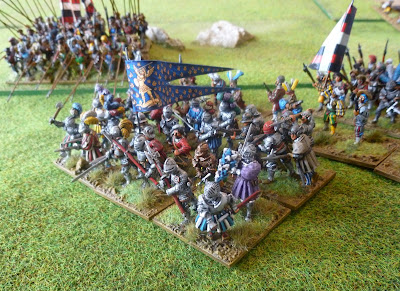
Here are a few pictures of a recently completed unit, a group of dismounted gendarmes. They are perfect for an up and coming scenario that I have planned this month. The figures are by Steel Fist,
https://www.steelfistminiatures.com/product-category/italian-wars-1494-1538/, and they really look the part. All have interchangeable heads and plumes, whilst some of the poses are open handed, or can have their weapons swapped with relative ease. This means that plenty of variation can be achieved within a unit.
Whilst the classic image of 16th century gendarmes is of them fighting on horseback, often on barded horses, they did at times dismount and fight on foot when required. They were not always keen to do this. During the 1509 siege of Padua, a rare occasion when Imperialist and French forces were allied, the assaults upon the breaches in Padua's walls were going so badly that on 29 September Maximilian I was forced to ask the French and German heavy cavalry to join a final assault against the Venetian held city. La Palice, in command of the French cavalry, reported to Maximilian that they were prepared to join the assault on foot only if the German men at arms would be joining them. Upon hearing this the German heavy cavalry made a fuss and stated it was below their dignity to dismount or storm a breach and that true gentlemen fought on horseback. By October 3 1509 the assault was abandoned as was the siege!
Whilst the example above shows there could be reluctance to perform such roles, there were occasions when gendarmes did dismount, either to assault positions or to stiffen the defences of fortifications. The siege of Rhodes in 1522 is a famous example of Knights Hospitaller from all over Europe defending the cities walls on foot against Suleiman the Magnificent's Ottoman army. This could happen on the battlefield too with Robert de La Marck, better known as Fleuranges, and his brother, fighting on foot with the landsknecht in French service at Novara in 1513 and Claude de Guise fighting amongst the landsknecht at Marignano in 1515. Guise also led a force of landsknecht across the River Bidassoa under heavy fire from Spanish forces during the 1521 French invasion of Navarre, whilst a year later Anne de Montmorency, under nominal command of the Swiss at La Bicocca , was joined by other French nobles and accompanied the Swiss in their ill-fated assault on the sunken road.
As such this is a useful unit to have as the figures are suitable for different roles in siege scenarios and can be mixed in with other units to represent them being joined by dismounted nobles as in the examples above. In the last three photos below I have mixed these new bases in with some of the more generic 16th infantry I painted up a few years ago:
http://camisado1500s.blogspot.com/2018/05/early-16th-century-infantry.html. This could represent them being joined by other infantry for the assault or perhaps show other members of the "lance", the men at arms, "archers" and squires who supported the gendarmes and formed the Compagnies d'ordonnance. The new figures work really well when mixed in with their less heavily armoured comrades.
 |
| 28mm Steel Fist dismounted gendarmes |
 |
| Dismounted gendarmes storm the walls of a besieged fortress |
 |
| Dismounted gendarmes storm the breach |
 |
| 28mm dismounted gendarmes |
 |
| Dismounted French gendarmes and the supporting members of the "lance" form a unit on foot |
 |
| French gendarmes and their supporting men at arms and archers storm a breach |
 |
| A unit of dismounted French gendarmes and support troops |









A useful and spectacular addition
ReplyDeleteStephen
Cheers Stephen, yes they should be useful for lots of games.
DeleteVery nice-looking figures indeed Oli!
ReplyDeleteCheers rross
DeleteBeautiful work, Oli! I have not seen dismounted gendarmes before. Good addition to your massive collection.
ReplyDeleteThank you Jonathan, the collection is an endless work in progress.
Delete